Healthcare Professionals: Substance Abuse Analysis and Strategies
VerifiedAdded on 2022/08/28
|16
|4040
|23
Report
AI Summary
This report, focusing on substance abuse in healthcare professionals, examines the critical issue of substance misuse among healthcare providers, particularly nurses. It delves into the adverse effects of substance abuse, including medication errors, impaired judgment, and the impact on patient care. The report outlines a framework for evaluating substance abuse issues, emphasizing outcome indicators and assessment methods like interviews and focus groups. It also identifies significant barriers to treatment, such as denial, stigma, and organizational policies. Finally, the report proposes various strategies to address these challenges, including creating a supportive environment, promoting education, and implementing effective intervention programs. The report highlights the need for a comprehensive approach to protect both healthcare professionals and patients.
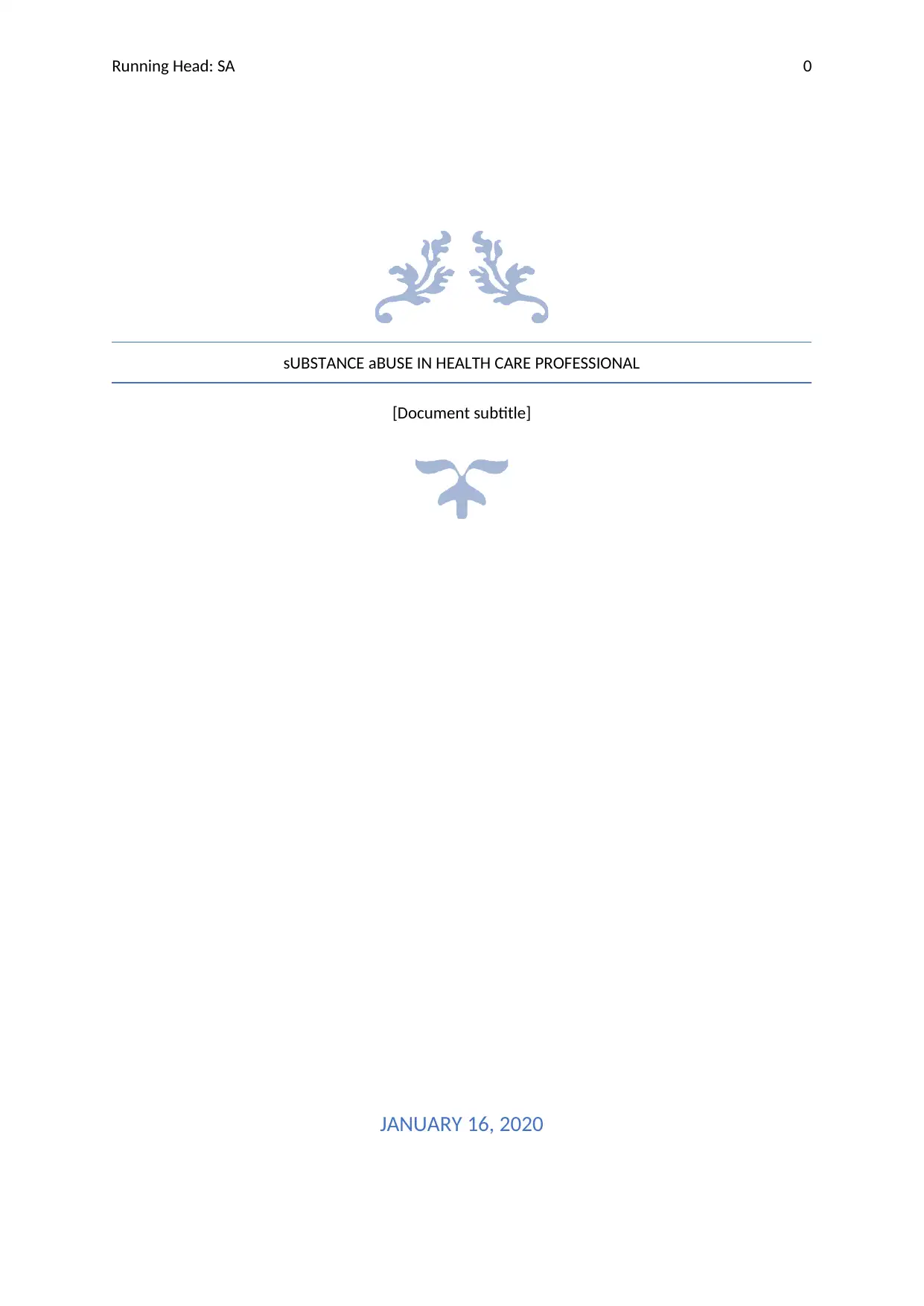
Running Head: SA 0
sUBSTANCE aBUSE IN HEALTH CARE PROFESSIONAL
[Document subtitle]
JANUARY 16, 2020
sUBSTANCE aBUSE IN HEALTH CARE PROFESSIONAL
[Document subtitle]
JANUARY 16, 2020
Paraphrase This Document
Need a fresh take? Get an instant paraphrase of this document with our AI Paraphraser
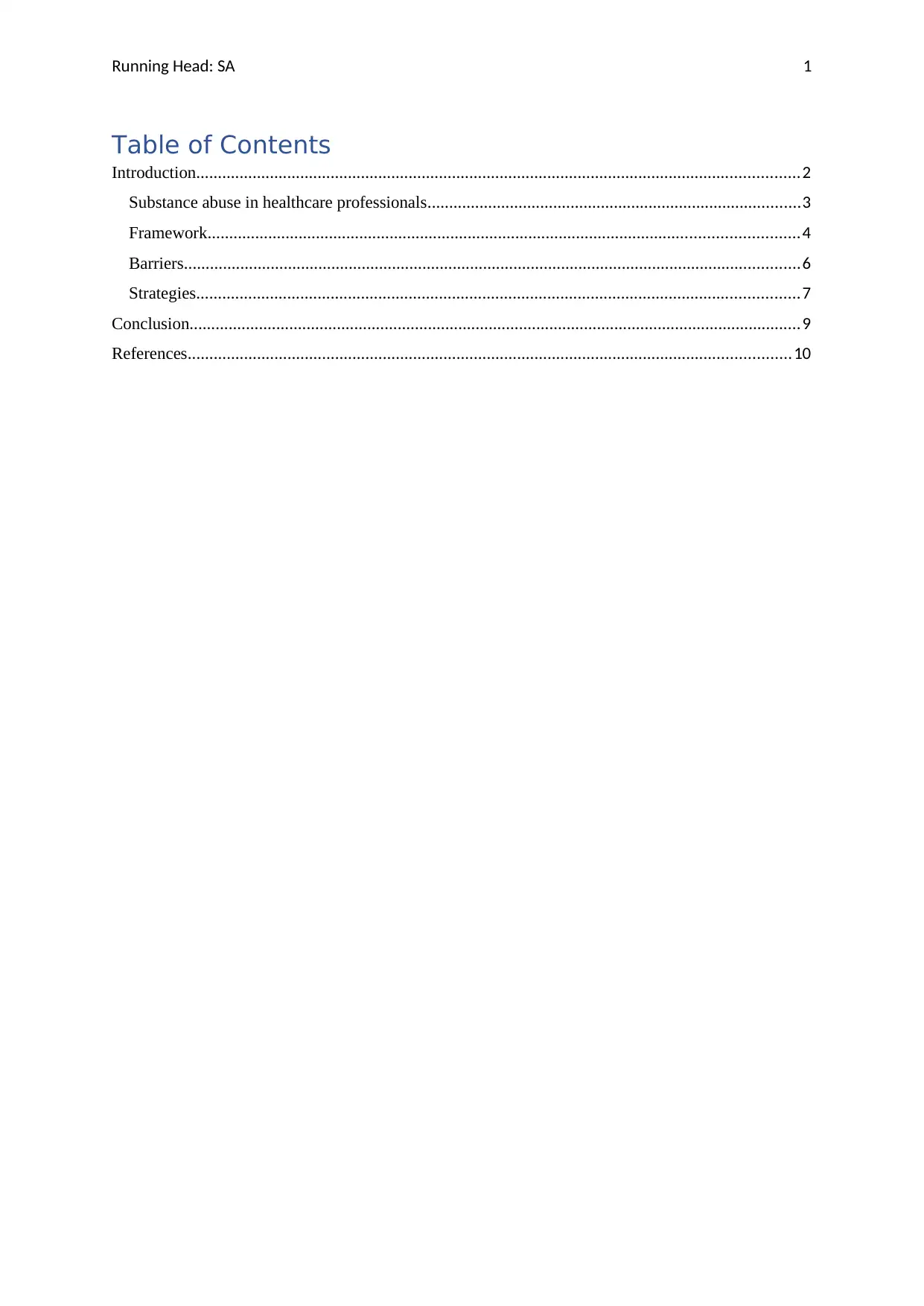
Running Head: SA 1
Table of Contents
Introduction...........................................................................................................................................2
Substance abuse in healthcare professionals......................................................................................3
Framework........................................................................................................................................4
Barriers..............................................................................................................................................6
Strategies...........................................................................................................................................7
Conclusion.............................................................................................................................................9
References...........................................................................................................................................10
Table of Contents
Introduction...........................................................................................................................................2
Substance abuse in healthcare professionals......................................................................................3
Framework........................................................................................................................................4
Barriers..............................................................................................................................................6
Strategies...........................................................................................................................................7
Conclusion.............................................................................................................................................9
References...........................................................................................................................................10
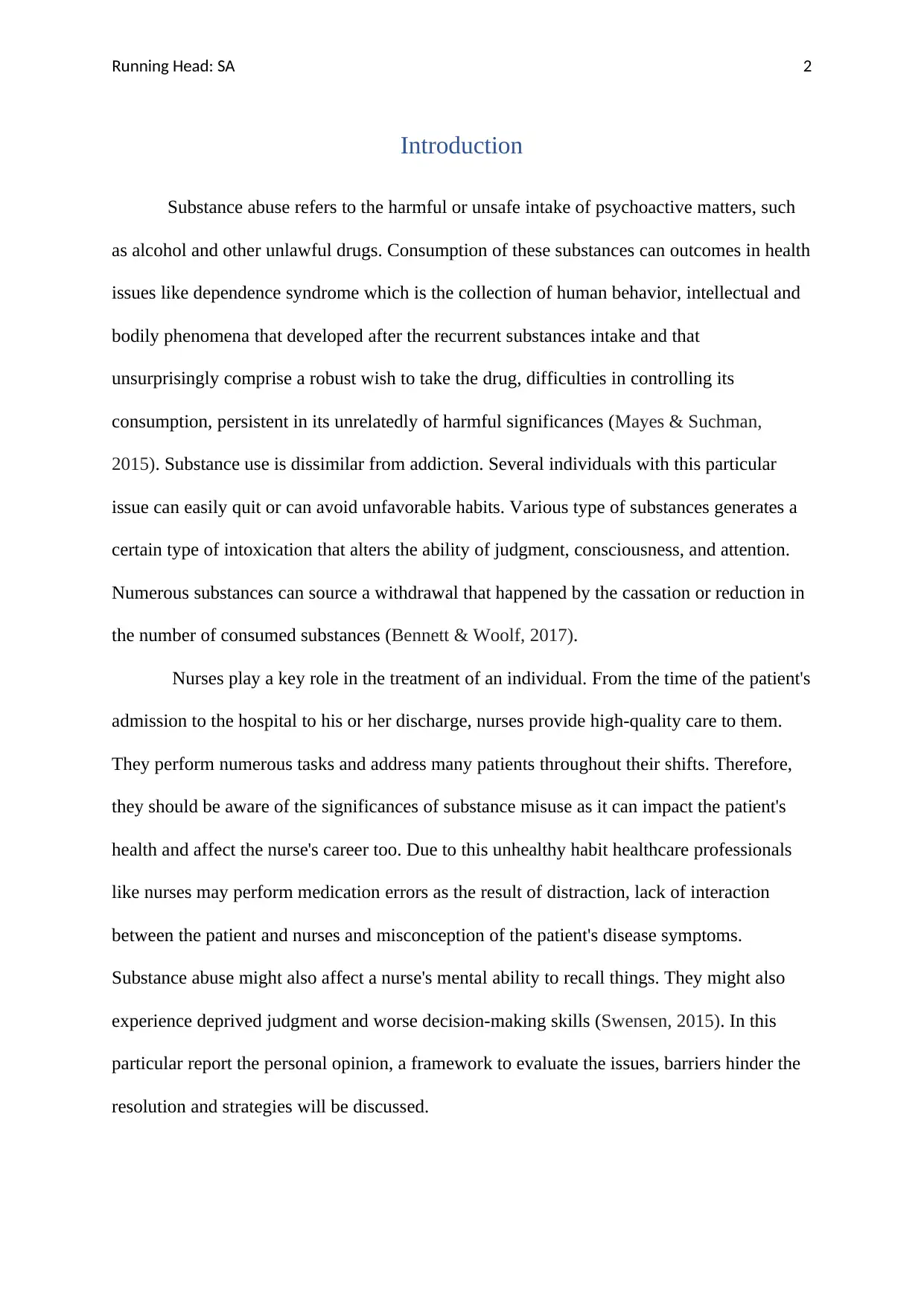
Running Head: SA 2
Introduction
Substance abuse refers to the harmful or unsafe intake of psychoactive matters, such
as alcohol and other unlawful drugs. Consumption of these substances can outcomes in health
issues like dependence syndrome which is the collection of human behavior, intellectual and
bodily phenomena that developed after the recurrent substances intake and that
unsurprisingly comprise a robust wish to take the drug, difficulties in controlling its
consumption, persistent in its unrelatedly of harmful significances (Mayes & Suchman,
2015). Substance use is dissimilar from addiction. Several individuals with this particular
issue can easily quit or can avoid unfavorable habits. Various type of substances generates a
certain type of intoxication that alters the ability of judgment, consciousness, and attention.
Numerous substances can source a withdrawal that happened by the cassation or reduction in
the number of consumed substances (Bennett & Woolf, 2017).
Nurses play a key role in the treatment of an individual. From the time of the patient's
admission to the hospital to his or her discharge, nurses provide high-quality care to them.
They perform numerous tasks and address many patients throughout their shifts. Therefore,
they should be aware of the significances of substance misuse as it can impact the patient's
health and affect the nurse's career too. Due to this unhealthy habit healthcare professionals
like nurses may perform medication errors as the result of distraction, lack of interaction
between the patient and nurses and misconception of the patient's disease symptoms.
Substance abuse might also affect a nurse's mental ability to recall things. They might also
experience deprived judgment and worse decision-making skills (Swensen, 2015). In this
particular report the personal opinion, a framework to evaluate the issues, barriers hinder the
resolution and strategies will be discussed.
Introduction
Substance abuse refers to the harmful or unsafe intake of psychoactive matters, such
as alcohol and other unlawful drugs. Consumption of these substances can outcomes in health
issues like dependence syndrome which is the collection of human behavior, intellectual and
bodily phenomena that developed after the recurrent substances intake and that
unsurprisingly comprise a robust wish to take the drug, difficulties in controlling its
consumption, persistent in its unrelatedly of harmful significances (Mayes & Suchman,
2015). Substance use is dissimilar from addiction. Several individuals with this particular
issue can easily quit or can avoid unfavorable habits. Various type of substances generates a
certain type of intoxication that alters the ability of judgment, consciousness, and attention.
Numerous substances can source a withdrawal that happened by the cassation or reduction in
the number of consumed substances (Bennett & Woolf, 2017).
Nurses play a key role in the treatment of an individual. From the time of the patient's
admission to the hospital to his or her discharge, nurses provide high-quality care to them.
They perform numerous tasks and address many patients throughout their shifts. Therefore,
they should be aware of the significances of substance misuse as it can impact the patient's
health and affect the nurse's career too. Due to this unhealthy habit healthcare professionals
like nurses may perform medication errors as the result of distraction, lack of interaction
between the patient and nurses and misconception of the patient's disease symptoms.
Substance abuse might also affect a nurse's mental ability to recall things. They might also
experience deprived judgment and worse decision-making skills (Swensen, 2015). In this
particular report the personal opinion, a framework to evaluate the issues, barriers hinder the
resolution and strategies will be discussed.
⊘ This is a preview!⊘
Do you want full access?
Subscribe today to unlock all pages.

Trusted by 1+ million students worldwide
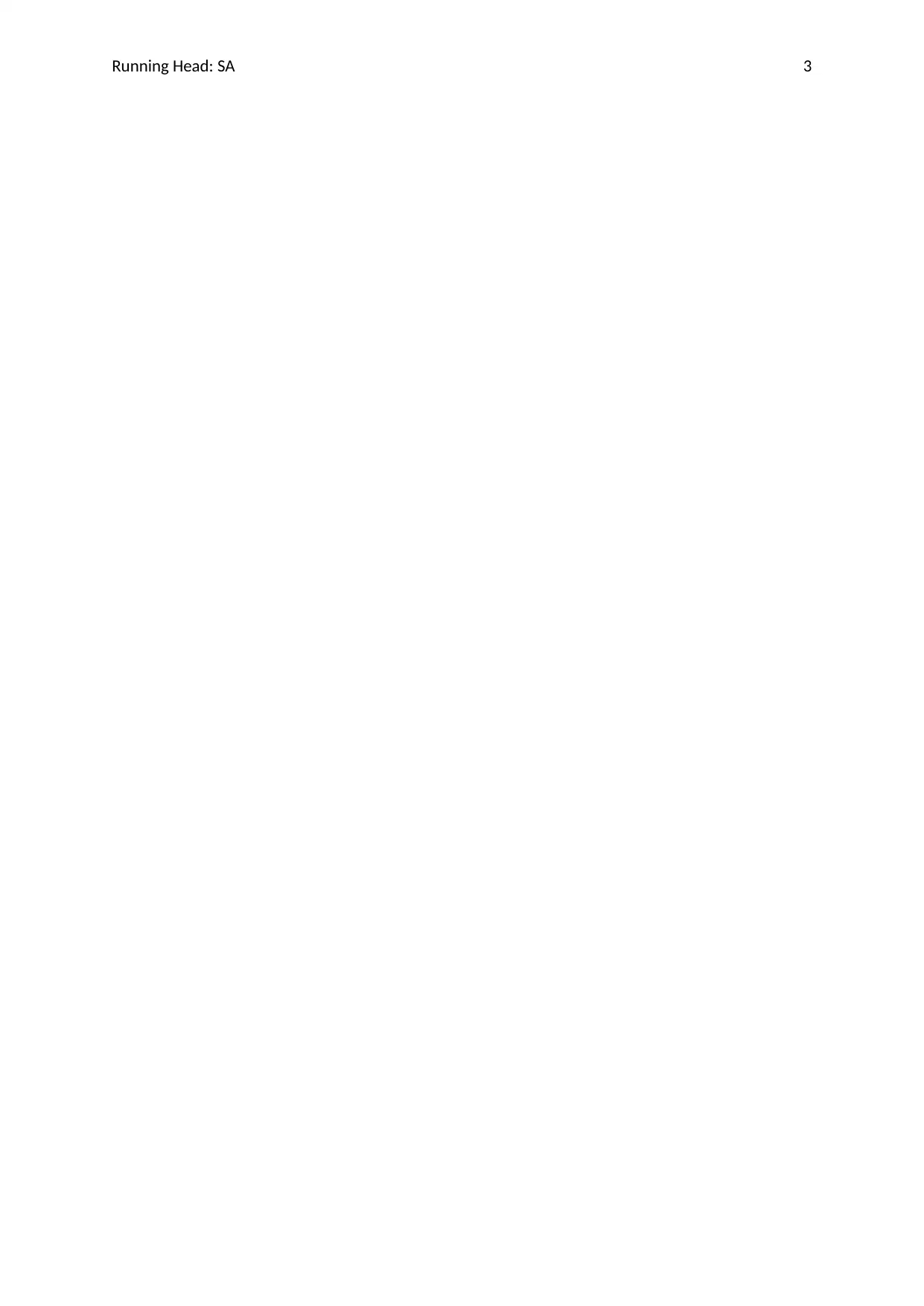
Running Head: SA 3
Paraphrase This Document
Need a fresh take? Get an instant paraphrase of this document with our AI Paraphraser
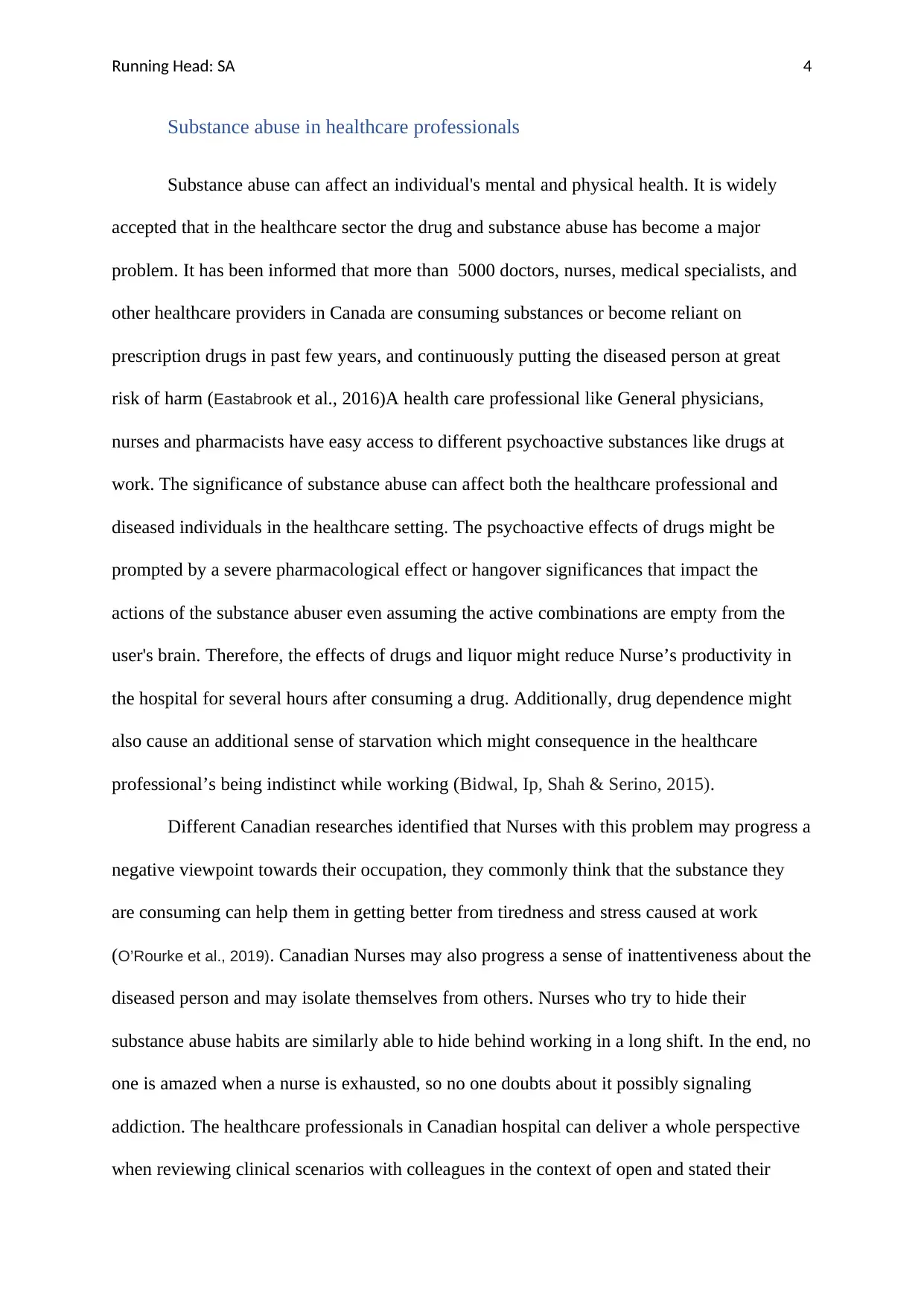
Running Head: SA 4
Substance abuse in healthcare professionals
Substance abuse can affect an individual's mental and physical health. It is widely
accepted that in the healthcare sector the drug and substance abuse has become a major
problem. It has been informed that more than 5000 doctors, nurses, medical specialists, and
other healthcare providers in Canada are consuming substances or become reliant on
prescription drugs in past few years, and continuously putting the diseased person at great
risk of harm (Eastabrook et al., 2016)A health care professional like General physicians,
nurses and pharmacists have easy access to different psychoactive substances like drugs at
work. The significance of substance abuse can affect both the healthcare professional and
diseased individuals in the healthcare setting. The psychoactive effects of drugs might be
prompted by a severe pharmacological effect or hangover significances that impact the
actions of the substance abuser even assuming the active combinations are empty from the
user's brain. Therefore, the effects of drugs and liquor might reduce Nurse’s productivity in
the hospital for several hours after consuming a drug. Additionally, drug dependence might
also cause an additional sense of starvation which might consequence in the healthcare
professional’s being indistinct while working (Bidwal, Ip, Shah & Serino, 2015).
Different Canadian researches identified that Nurses with this problem may progress a
negative viewpoint towards their occupation, they commonly think that the substance they
are consuming can help them in getting better from tiredness and stress caused at work
(O’Rourke et al., 2019). Canadian Nurses may also progress a sense of inattentiveness about the
diseased person and may isolate themselves from others. Nurses who try to hide their
substance abuse habits are similarly able to hide behind working in a long shift. In the end, no
one is amazed when a nurse is exhausted, so no one doubts about it possibly signaling
addiction. The healthcare professionals in Canadian hospital can deliver a whole perspective
when reviewing clinical scenarios with colleagues in the context of open and stated their
Substance abuse in healthcare professionals
Substance abuse can affect an individual's mental and physical health. It is widely
accepted that in the healthcare sector the drug and substance abuse has become a major
problem. It has been informed that more than 5000 doctors, nurses, medical specialists, and
other healthcare providers in Canada are consuming substances or become reliant on
prescription drugs in past few years, and continuously putting the diseased person at great
risk of harm (Eastabrook et al., 2016)A health care professional like General physicians,
nurses and pharmacists have easy access to different psychoactive substances like drugs at
work. The significance of substance abuse can affect both the healthcare professional and
diseased individuals in the healthcare setting. The psychoactive effects of drugs might be
prompted by a severe pharmacological effect or hangover significances that impact the
actions of the substance abuser even assuming the active combinations are empty from the
user's brain. Therefore, the effects of drugs and liquor might reduce Nurse’s productivity in
the hospital for several hours after consuming a drug. Additionally, drug dependence might
also cause an additional sense of starvation which might consequence in the healthcare
professional’s being indistinct while working (Bidwal, Ip, Shah & Serino, 2015).
Different Canadian researches identified that Nurses with this problem may progress a
negative viewpoint towards their occupation, they commonly think that the substance they
are consuming can help them in getting better from tiredness and stress caused at work
(O’Rourke et al., 2019). Canadian Nurses may also progress a sense of inattentiveness about the
diseased person and may isolate themselves from others. Nurses who try to hide their
substance abuse habits are similarly able to hide behind working in a long shift. In the end, no
one is amazed when a nurse is exhausted, so no one doubts about it possibly signaling
addiction. The healthcare professionals in Canadian hospital can deliver a whole perspective
when reviewing clinical scenarios with colleagues in the context of open and stated their
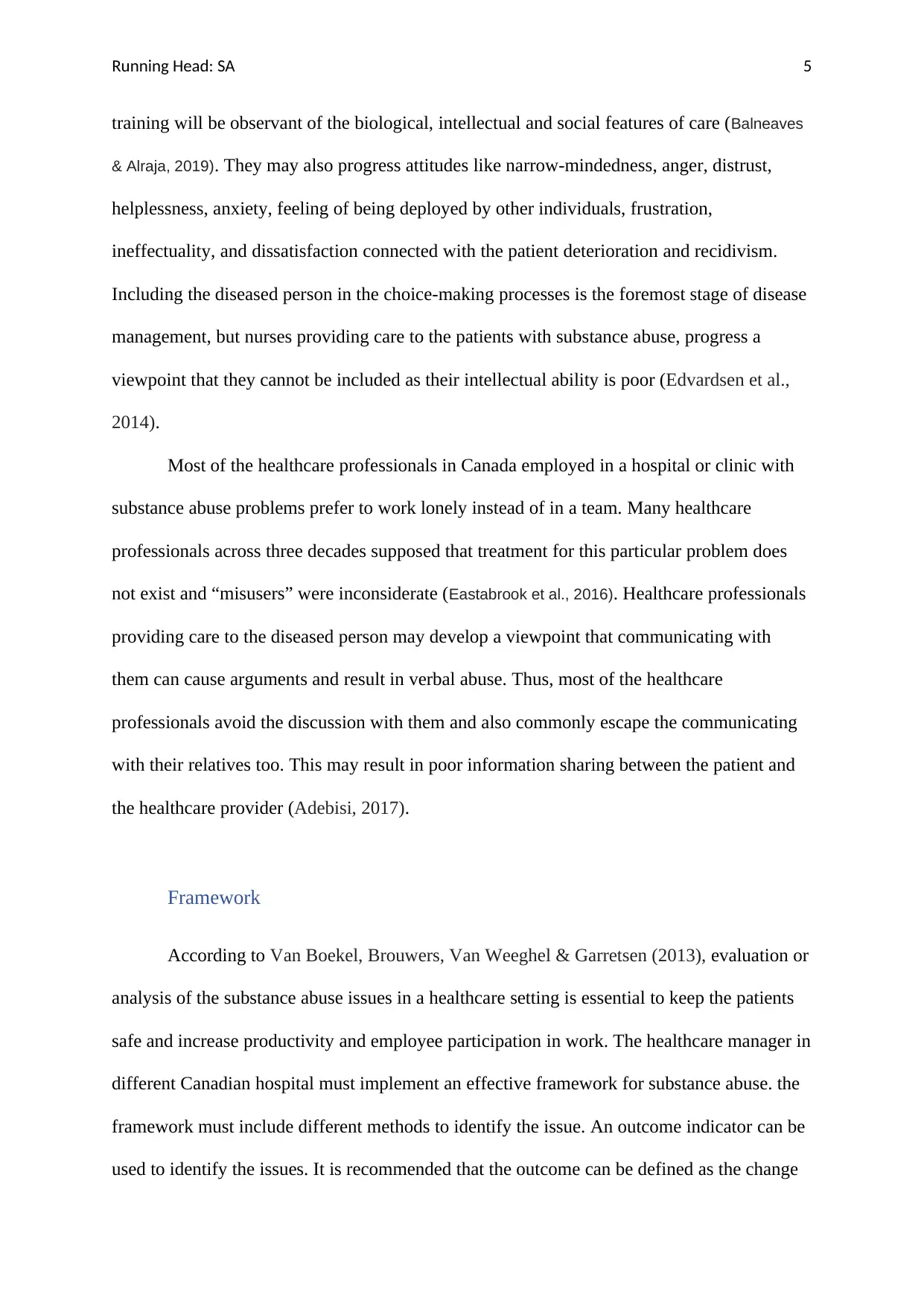
Running Head: SA 5
training will be observant of the biological, intellectual and social features of care (Balneaves
& Alraja, 2019). They may also progress attitudes like narrow-mindedness, anger, distrust,
helplessness, anxiety, feeling of being deployed by other individuals, frustration,
ineffectuality, and dissatisfaction connected with the patient deterioration and recidivism.
Including the diseased person in the choice-making processes is the foremost stage of disease
management, but nurses providing care to the patients with substance abuse, progress a
viewpoint that they cannot be included as their intellectual ability is poor (Edvardsen et al.,
2014).
Most of the healthcare professionals in Canada employed in a hospital or clinic with
substance abuse problems prefer to work lonely instead of in a team. Many healthcare
professionals across three decades supposed that treatment for this particular problem does
not exist and “misusers” were inconsiderate (Eastabrook et al., 2016). Healthcare professionals
providing care to the diseased person may develop a viewpoint that communicating with
them can cause arguments and result in verbal abuse. Thus, most of the healthcare
professionals avoid the discussion with them and also commonly escape the communicating
with their relatives too. This may result in poor information sharing between the patient and
the healthcare provider (Adebisi, 2017).
Framework
According to Van Boekel, Brouwers, Van Weeghel & Garretsen (2013), evaluation or
analysis of the substance abuse issues in a healthcare setting is essential to keep the patients
safe and increase productivity and employee participation in work. The healthcare manager in
different Canadian hospital must implement an effective framework for substance abuse. the
framework must include different methods to identify the issue. An outcome indicator can be
used to identify the issues. It is recommended that the outcome can be defined as the change
training will be observant of the biological, intellectual and social features of care (Balneaves
& Alraja, 2019). They may also progress attitudes like narrow-mindedness, anger, distrust,
helplessness, anxiety, feeling of being deployed by other individuals, frustration,
ineffectuality, and dissatisfaction connected with the patient deterioration and recidivism.
Including the diseased person in the choice-making processes is the foremost stage of disease
management, but nurses providing care to the patients with substance abuse, progress a
viewpoint that they cannot be included as their intellectual ability is poor (Edvardsen et al.,
2014).
Most of the healthcare professionals in Canada employed in a hospital or clinic with
substance abuse problems prefer to work lonely instead of in a team. Many healthcare
professionals across three decades supposed that treatment for this particular problem does
not exist and “misusers” were inconsiderate (Eastabrook et al., 2016). Healthcare professionals
providing care to the diseased person may develop a viewpoint that communicating with
them can cause arguments and result in verbal abuse. Thus, most of the healthcare
professionals avoid the discussion with them and also commonly escape the communicating
with their relatives too. This may result in poor information sharing between the patient and
the healthcare provider (Adebisi, 2017).
Framework
According to Van Boekel, Brouwers, Van Weeghel & Garretsen (2013), evaluation or
analysis of the substance abuse issues in a healthcare setting is essential to keep the patients
safe and increase productivity and employee participation in work. The healthcare manager in
different Canadian hospital must implement an effective framework for substance abuse. the
framework must include different methods to identify the issue. An outcome indicator can be
used to identify the issues. It is recommended that the outcome can be defined as the change
⊘ This is a preview!⊘
Do you want full access?
Subscribe today to unlock all pages.

Trusted by 1+ million students worldwide
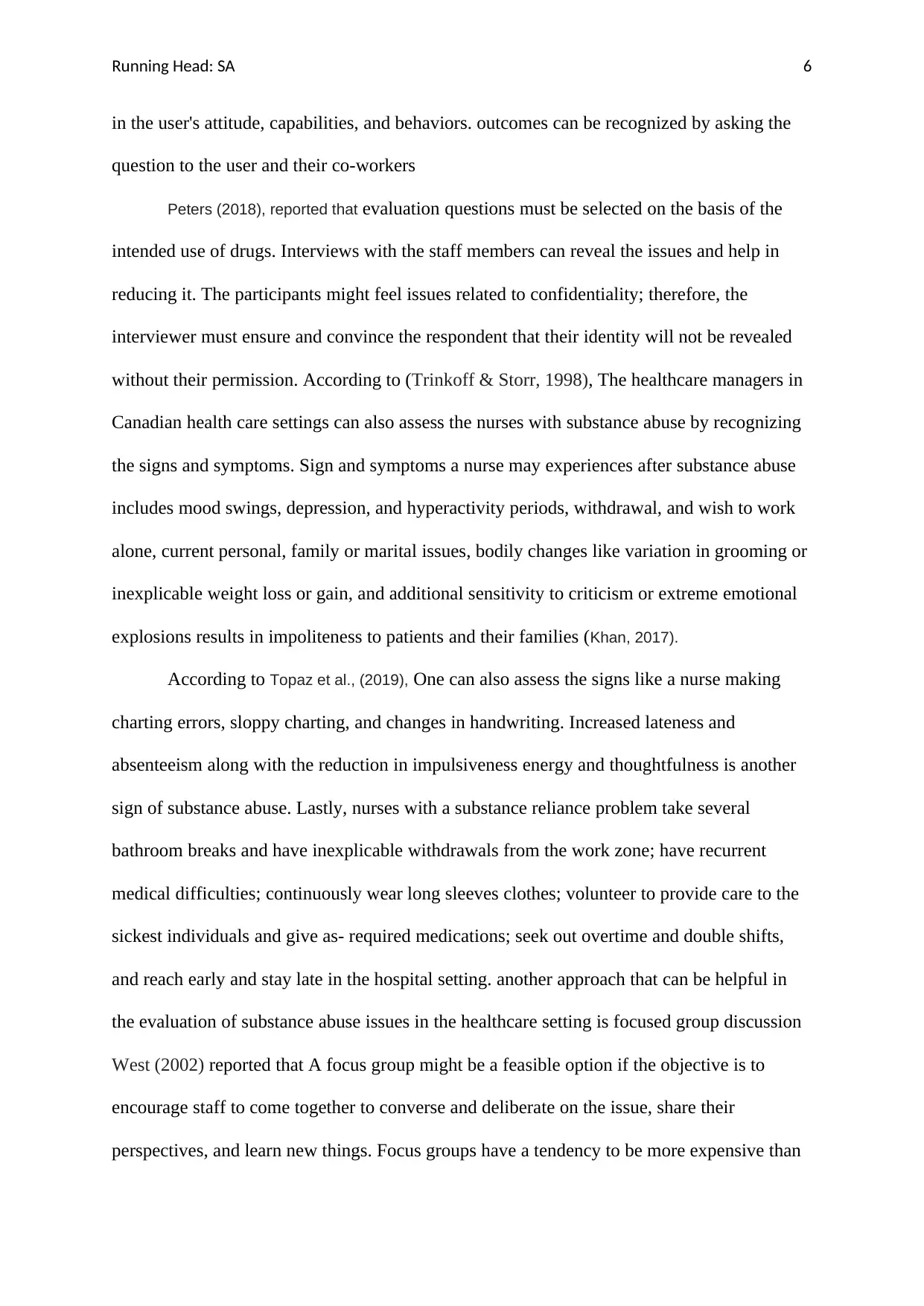
Running Head: SA 6
in the user's attitude, capabilities, and behaviors. outcomes can be recognized by asking the
question to the user and their co-workers
Peters (2018), reported that evaluation questions must be selected on the basis of the
intended use of drugs. Interviews with the staff members can reveal the issues and help in
reducing it. The participants might feel issues related to confidentiality; therefore, the
interviewer must ensure and convince the respondent that their identity will not be revealed
without their permission. According to (Trinkoff & Storr, 1998), The healthcare managers in
Canadian health care settings can also assess the nurses with substance abuse by recognizing
the signs and symptoms. Sign and symptoms a nurse may experiences after substance abuse
includes mood swings, depression, and hyperactivity periods, withdrawal, and wish to work
alone, current personal, family or marital issues, bodily changes like variation in grooming or
inexplicable weight loss or gain, and additional sensitivity to criticism or extreme emotional
explosions results in impoliteness to patients and their families (Khan, 2017).
According to Topaz et al., (2019), One can also assess the signs like a nurse making
charting errors, sloppy charting, and changes in handwriting. Increased lateness and
absenteeism along with the reduction in impulsiveness energy and thoughtfulness is another
sign of substance abuse. Lastly, nurses with a substance reliance problem take several
bathroom breaks and have inexplicable withdrawals from the work zone; have recurrent
medical difficulties; continuously wear long sleeves clothes; volunteer to provide care to the
sickest individuals and give as- required medications; seek out overtime and double shifts,
and reach early and stay late in the hospital setting. another approach that can be helpful in
the evaluation of substance abuse issues in the healthcare setting is focused group discussion
West (2002) reported that A focus group might be a feasible option if the objective is to
encourage staff to come together to converse and deliberate on the issue, share their
perspectives, and learn new things. Focus groups have a tendency to be more expensive than
in the user's attitude, capabilities, and behaviors. outcomes can be recognized by asking the
question to the user and their co-workers
Peters (2018), reported that evaluation questions must be selected on the basis of the
intended use of drugs. Interviews with the staff members can reveal the issues and help in
reducing it. The participants might feel issues related to confidentiality; therefore, the
interviewer must ensure and convince the respondent that their identity will not be revealed
without their permission. According to (Trinkoff & Storr, 1998), The healthcare managers in
Canadian health care settings can also assess the nurses with substance abuse by recognizing
the signs and symptoms. Sign and symptoms a nurse may experiences after substance abuse
includes mood swings, depression, and hyperactivity periods, withdrawal, and wish to work
alone, current personal, family or marital issues, bodily changes like variation in grooming or
inexplicable weight loss or gain, and additional sensitivity to criticism or extreme emotional
explosions results in impoliteness to patients and their families (Khan, 2017).
According to Topaz et al., (2019), One can also assess the signs like a nurse making
charting errors, sloppy charting, and changes in handwriting. Increased lateness and
absenteeism along with the reduction in impulsiveness energy and thoughtfulness is another
sign of substance abuse. Lastly, nurses with a substance reliance problem take several
bathroom breaks and have inexplicable withdrawals from the work zone; have recurrent
medical difficulties; continuously wear long sleeves clothes; volunteer to provide care to the
sickest individuals and give as- required medications; seek out overtime and double shifts,
and reach early and stay late in the hospital setting. another approach that can be helpful in
the evaluation of substance abuse issues in the healthcare setting is focused group discussion
West (2002) reported that A focus group might be a feasible option if the objective is to
encourage staff to come together to converse and deliberate on the issue, share their
perspectives, and learn new things. Focus groups have a tendency to be more expensive than
Paraphrase This Document
Need a fresh take? Get an instant paraphrase of this document with our AI Paraphraser
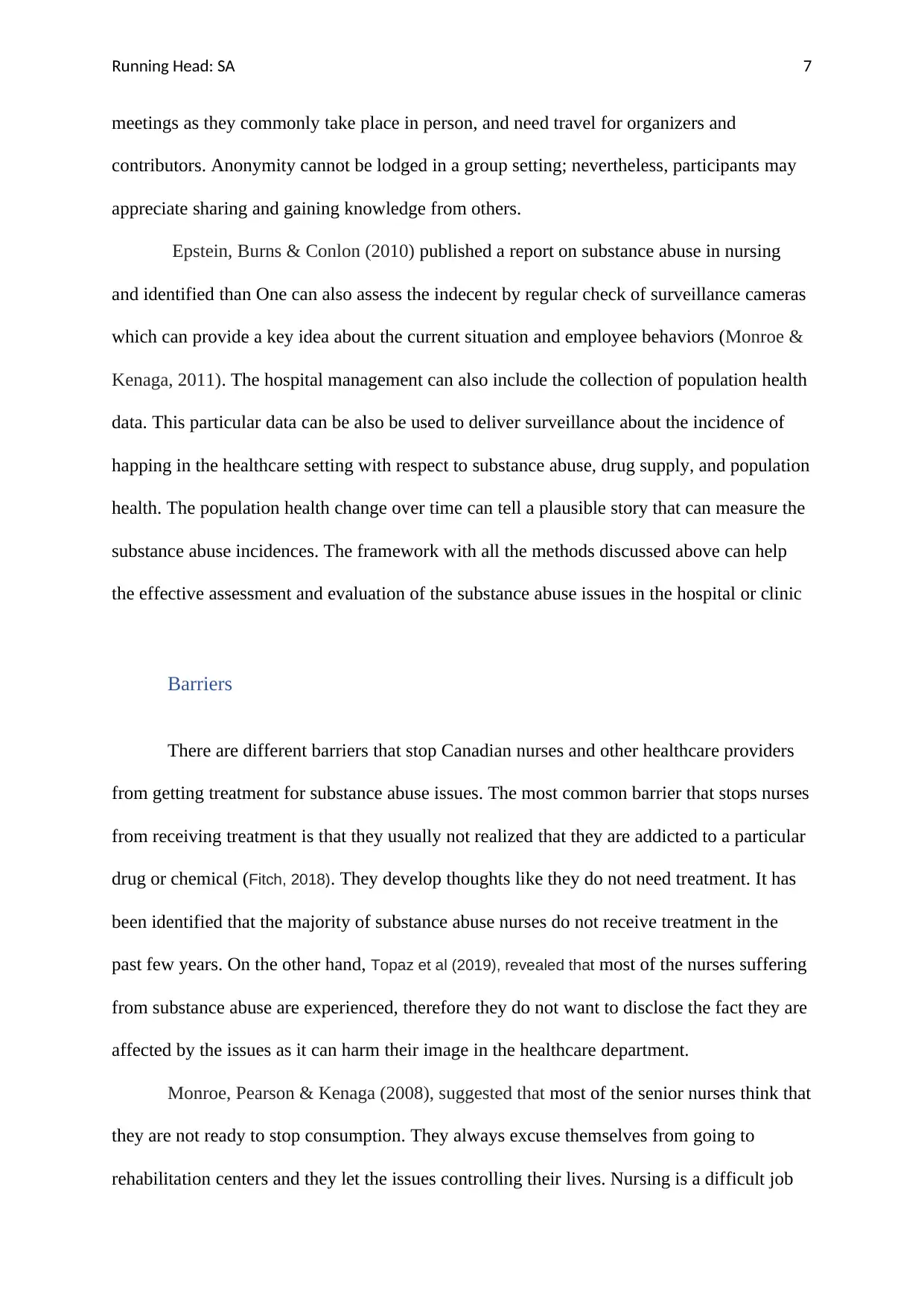
Running Head: SA 7
meetings as they commonly take place in person, and need travel for organizers and
contributors. Anonymity cannot be lodged in a group setting; nevertheless, participants may
appreciate sharing and gaining knowledge from others.
Epstein, Burns & Conlon (2010) published a report on substance abuse in nursing
and identified than One can also assess the indecent by regular check of surveillance cameras
which can provide a key idea about the current situation and employee behaviors (Monroe &
Kenaga, 2011). The hospital management can also include the collection of population health
data. This particular data can be also be used to deliver surveillance about the incidence of
happing in the healthcare setting with respect to substance abuse, drug supply, and population
health. The population health change over time can tell a plausible story that can measure the
substance abuse incidences. The framework with all the methods discussed above can help
the effective assessment and evaluation of the substance abuse issues in the hospital or clinic
Barriers
There are different barriers that stop Canadian nurses and other healthcare providers
from getting treatment for substance abuse issues. The most common barrier that stops nurses
from receiving treatment is that they usually not realized that they are addicted to a particular
drug or chemical (Fitch, 2018). They develop thoughts like they do not need treatment. It has
been identified that the majority of substance abuse nurses do not receive treatment in the
past few years. On the other hand, Topaz et al (2019), revealed that most of the nurses suffering
from substance abuse are experienced, therefore they do not want to disclose the fact they are
affected by the issues as it can harm their image in the healthcare department.
Monroe, Pearson & Kenaga (2008), suggested that most of the senior nurses think that
they are not ready to stop consumption. They always excuse themselves from going to
rehabilitation centers and they let the issues controlling their lives. Nursing is a difficult job
meetings as they commonly take place in person, and need travel for organizers and
contributors. Anonymity cannot be lodged in a group setting; nevertheless, participants may
appreciate sharing and gaining knowledge from others.
Epstein, Burns & Conlon (2010) published a report on substance abuse in nursing
and identified than One can also assess the indecent by regular check of surveillance cameras
which can provide a key idea about the current situation and employee behaviors (Monroe &
Kenaga, 2011). The hospital management can also include the collection of population health
data. This particular data can be also be used to deliver surveillance about the incidence of
happing in the healthcare setting with respect to substance abuse, drug supply, and population
health. The population health change over time can tell a plausible story that can measure the
substance abuse incidences. The framework with all the methods discussed above can help
the effective assessment and evaluation of the substance abuse issues in the hospital or clinic
Barriers
There are different barriers that stop Canadian nurses and other healthcare providers
from getting treatment for substance abuse issues. The most common barrier that stops nurses
from receiving treatment is that they usually not realized that they are addicted to a particular
drug or chemical (Fitch, 2018). They develop thoughts like they do not need treatment. It has
been identified that the majority of substance abuse nurses do not receive treatment in the
past few years. On the other hand, Topaz et al (2019), revealed that most of the nurses suffering
from substance abuse are experienced, therefore they do not want to disclose the fact they are
affected by the issues as it can harm their image in the healthcare department.
Monroe, Pearson & Kenaga (2008), suggested that most of the senior nurses think that
they are not ready to stop consumption. They always excuse themselves from going to
rehabilitation centers and they let the issues controlling their lives. Nursing is a difficult job
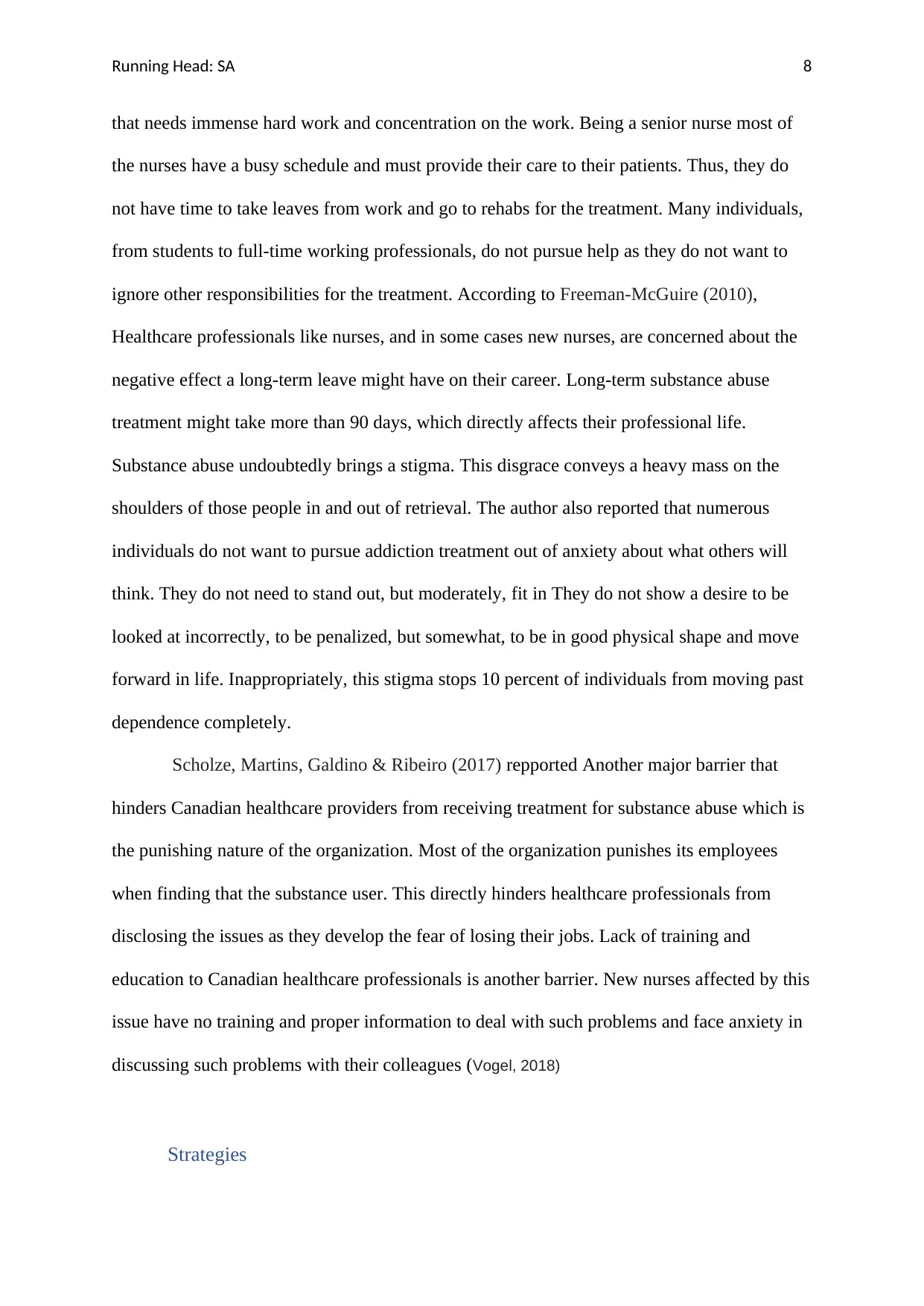
Running Head: SA 8
that needs immense hard work and concentration on the work. Being a senior nurse most of
the nurses have a busy schedule and must provide their care to their patients. Thus, they do
not have time to take leaves from work and go to rehabs for the treatment. Many individuals,
from students to full-time working professionals, do not pursue help as they do not want to
ignore other responsibilities for the treatment. According to Freeman-McGuire (2010),
Healthcare professionals like nurses, and in some cases new nurses, are concerned about the
negative effect a long-term leave might have on their career. Long-term substance abuse
treatment might take more than 90 days, which directly affects their professional life.
Substance abuse undoubtedly brings a stigma. This disgrace conveys a heavy mass on the
shoulders of those people in and out of retrieval. The author also reported that numerous
individuals do not want to pursue addiction treatment out of anxiety about what others will
think. They do not need to stand out, but moderately, fit in They do not show a desire to be
looked at incorrectly, to be penalized, but somewhat, to be in good physical shape and move
forward in life. Inappropriately, this stigma stops 10 percent of individuals from moving past
dependence completely.
Scholze, Martins, Galdino & Ribeiro (2017) repported Another major barrier that
hinders Canadian healthcare providers from receiving treatment for substance abuse which is
the punishing nature of the organization. Most of the organization punishes its employees
when finding that the substance user. This directly hinders healthcare professionals from
disclosing the issues as they develop the fear of losing their jobs. Lack of training and
education to Canadian healthcare professionals is another barrier. New nurses affected by this
issue have no training and proper information to deal with such problems and face anxiety in
discussing such problems with their colleagues (Vogel, 2018)
Strategies
that needs immense hard work and concentration on the work. Being a senior nurse most of
the nurses have a busy schedule and must provide their care to their patients. Thus, they do
not have time to take leaves from work and go to rehabs for the treatment. Many individuals,
from students to full-time working professionals, do not pursue help as they do not want to
ignore other responsibilities for the treatment. According to Freeman-McGuire (2010),
Healthcare professionals like nurses, and in some cases new nurses, are concerned about the
negative effect a long-term leave might have on their career. Long-term substance abuse
treatment might take more than 90 days, which directly affects their professional life.
Substance abuse undoubtedly brings a stigma. This disgrace conveys a heavy mass on the
shoulders of those people in and out of retrieval. The author also reported that numerous
individuals do not want to pursue addiction treatment out of anxiety about what others will
think. They do not need to stand out, but moderately, fit in They do not show a desire to be
looked at incorrectly, to be penalized, but somewhat, to be in good physical shape and move
forward in life. Inappropriately, this stigma stops 10 percent of individuals from moving past
dependence completely.
Scholze, Martins, Galdino & Ribeiro (2017) repported Another major barrier that
hinders Canadian healthcare providers from receiving treatment for substance abuse which is
the punishing nature of the organization. Most of the organization punishes its employees
when finding that the substance user. This directly hinders healthcare professionals from
disclosing the issues as they develop the fear of losing their jobs. Lack of training and
education to Canadian healthcare professionals is another barrier. New nurses affected by this
issue have no training and proper information to deal with such problems and face anxiety in
discussing such problems with their colleagues (Vogel, 2018)
Strategies
⊘ This is a preview!⊘
Do you want full access?
Subscribe today to unlock all pages.

Trusted by 1+ million students worldwide
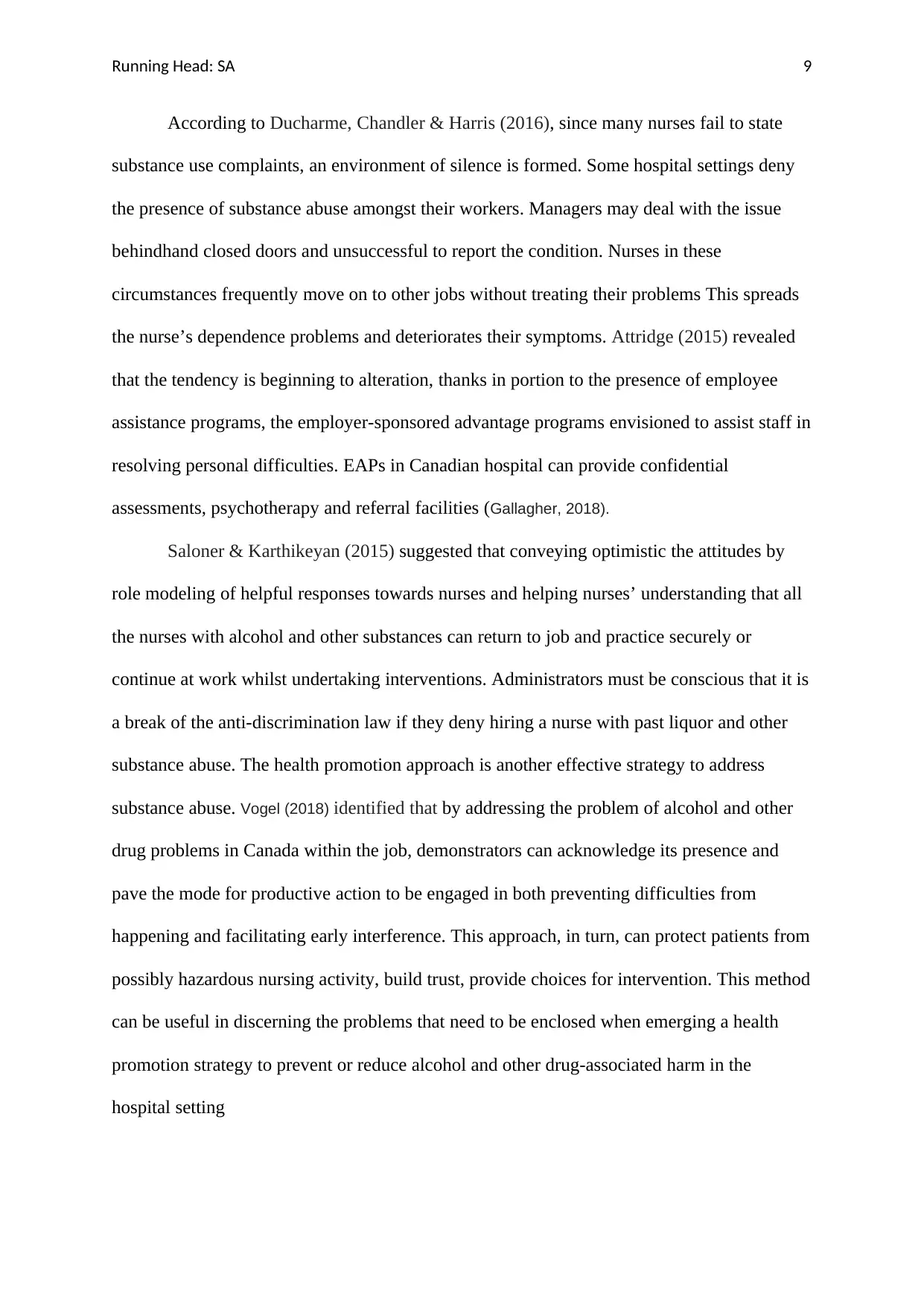
Running Head: SA 9
According to Ducharme, Chandler & Harris (2016), since many nurses fail to state
substance use complaints, an environment of silence is formed. Some hospital settings deny
the presence of substance abuse amongst their workers. Managers may deal with the issue
behindhand closed doors and unsuccessful to report the condition. Nurses in these
circumstances frequently move on to other jobs without treating their problems This spreads
the nurse’s dependence problems and deteriorates their symptoms. Attridge (2015) revealed
that the tendency is beginning to alteration, thanks in portion to the presence of employee
assistance programs, the employer-sponsored advantage programs envisioned to assist staff in
resolving personal difficulties. EAPs in Canadian hospital can provide confidential
assessments, psychotherapy and referral facilities (Gallagher, 2018).
Saloner & Karthikeyan (2015) suggested that conveying optimistic the attitudes by
role modeling of helpful responses towards nurses and helping nurses’ understanding that all
the nurses with alcohol and other substances can return to job and practice securely or
continue at work whilst undertaking interventions. Administrators must be conscious that it is
a break of the anti-discrimination law if they deny hiring a nurse with past liquor and other
substance abuse. The health promotion approach is another effective strategy to address
substance abuse. Vogel (2018) identified that by addressing the problem of alcohol and other
drug problems in Canada within the job, demonstrators can acknowledge its presence and
pave the mode for productive action to be engaged in both preventing difficulties from
happening and facilitating early interference. This approach, in turn, can protect patients from
possibly hazardous nursing activity, build trust, provide choices for intervention. This method
can be useful in discerning the problems that need to be enclosed when emerging a health
promotion strategy to prevent or reduce alcohol and other drug-associated harm in the
hospital setting
According to Ducharme, Chandler & Harris (2016), since many nurses fail to state
substance use complaints, an environment of silence is formed. Some hospital settings deny
the presence of substance abuse amongst their workers. Managers may deal with the issue
behindhand closed doors and unsuccessful to report the condition. Nurses in these
circumstances frequently move on to other jobs without treating their problems This spreads
the nurse’s dependence problems and deteriorates their symptoms. Attridge (2015) revealed
that the tendency is beginning to alteration, thanks in portion to the presence of employee
assistance programs, the employer-sponsored advantage programs envisioned to assist staff in
resolving personal difficulties. EAPs in Canadian hospital can provide confidential
assessments, psychotherapy and referral facilities (Gallagher, 2018).
Saloner & Karthikeyan (2015) suggested that conveying optimistic the attitudes by
role modeling of helpful responses towards nurses and helping nurses’ understanding that all
the nurses with alcohol and other substances can return to job and practice securely or
continue at work whilst undertaking interventions. Administrators must be conscious that it is
a break of the anti-discrimination law if they deny hiring a nurse with past liquor and other
substance abuse. The health promotion approach is another effective strategy to address
substance abuse. Vogel (2018) identified that by addressing the problem of alcohol and other
drug problems in Canada within the job, demonstrators can acknowledge its presence and
pave the mode for productive action to be engaged in both preventing difficulties from
happening and facilitating early interference. This approach, in turn, can protect patients from
possibly hazardous nursing activity, build trust, provide choices for intervention. This method
can be useful in discerning the problems that need to be enclosed when emerging a health
promotion strategy to prevent or reduce alcohol and other drug-associated harm in the
hospital setting
Paraphrase This Document
Need a fresh take? Get an instant paraphrase of this document with our AI Paraphraser
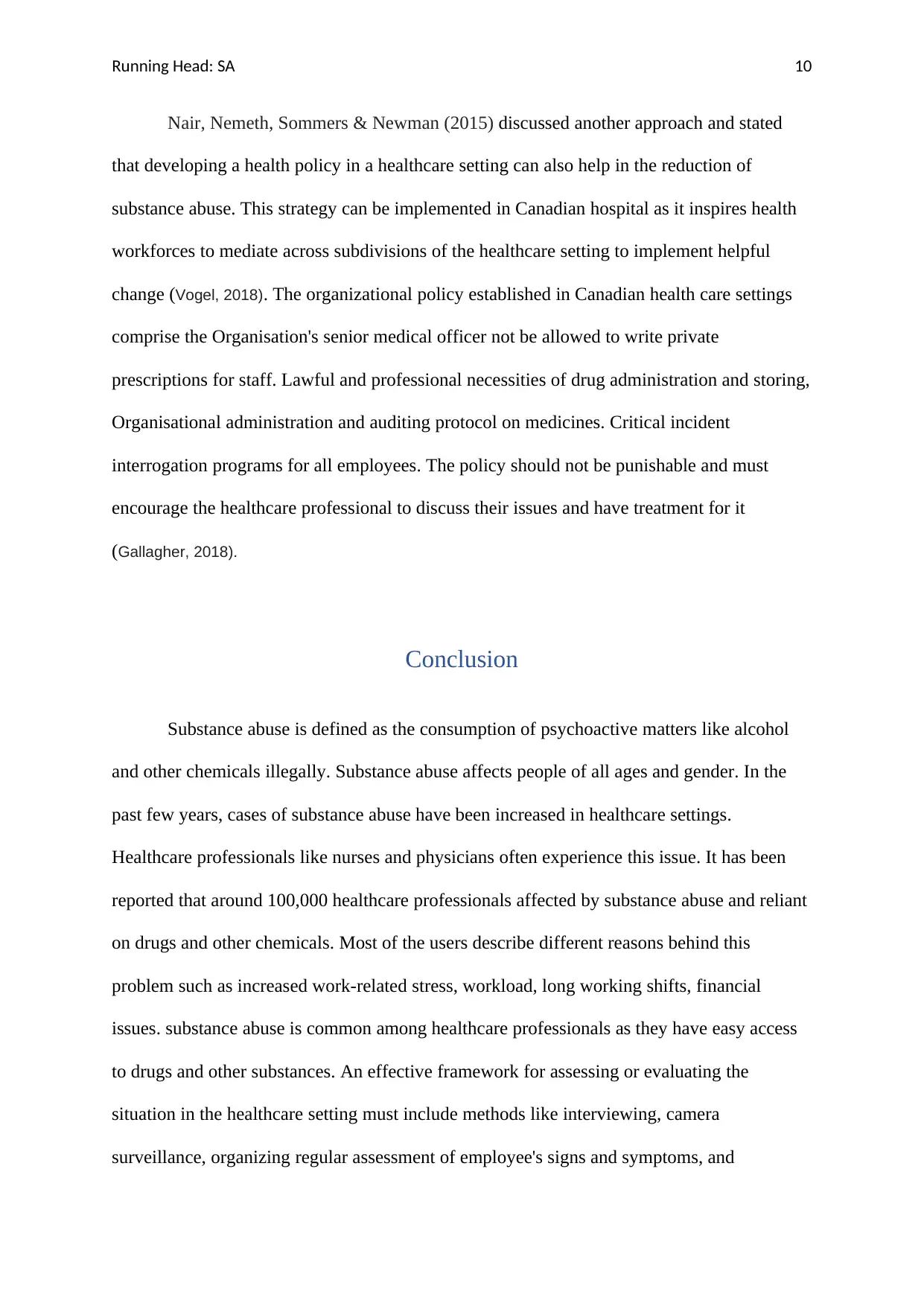
Running Head: SA 10
Nair, Nemeth, Sommers & Newman (2015) discussed another approach and stated
that developing a health policy in a healthcare setting can also help in the reduction of
substance abuse. This strategy can be implemented in Canadian hospital as it inspires health
workforces to mediate across subdivisions of the healthcare setting to implement helpful
change (Vogel, 2018). The organizational policy established in Canadian health care settings
comprise the Organisation's senior medical officer not be allowed to write private
prescriptions for staff. Lawful and professional necessities of drug administration and storing,
Organisational administration and auditing protocol on medicines. Critical incident
interrogation programs for all employees. The policy should not be punishable and must
encourage the healthcare professional to discuss their issues and have treatment for it
(Gallagher, 2018).
Conclusion
Substance abuse is defined as the consumption of psychoactive matters like alcohol
and other chemicals illegally. Substance abuse affects people of all ages and gender. In the
past few years, cases of substance abuse have been increased in healthcare settings.
Healthcare professionals like nurses and physicians often experience this issue. It has been
reported that around 100,000 healthcare professionals affected by substance abuse and reliant
on drugs and other chemicals. Most of the users describe different reasons behind this
problem such as increased work-related stress, workload, long working shifts, financial
issues. substance abuse is common among healthcare professionals as they have easy access
to drugs and other substances. An effective framework for assessing or evaluating the
situation in the healthcare setting must include methods like interviewing, camera
surveillance, organizing regular assessment of employee's signs and symptoms, and
Nair, Nemeth, Sommers & Newman (2015) discussed another approach and stated
that developing a health policy in a healthcare setting can also help in the reduction of
substance abuse. This strategy can be implemented in Canadian hospital as it inspires health
workforces to mediate across subdivisions of the healthcare setting to implement helpful
change (Vogel, 2018). The organizational policy established in Canadian health care settings
comprise the Organisation's senior medical officer not be allowed to write private
prescriptions for staff. Lawful and professional necessities of drug administration and storing,
Organisational administration and auditing protocol on medicines. Critical incident
interrogation programs for all employees. The policy should not be punishable and must
encourage the healthcare professional to discuss their issues and have treatment for it
(Gallagher, 2018).
Conclusion
Substance abuse is defined as the consumption of psychoactive matters like alcohol
and other chemicals illegally. Substance abuse affects people of all ages and gender. In the
past few years, cases of substance abuse have been increased in healthcare settings.
Healthcare professionals like nurses and physicians often experience this issue. It has been
reported that around 100,000 healthcare professionals affected by substance abuse and reliant
on drugs and other chemicals. Most of the users describe different reasons behind this
problem such as increased work-related stress, workload, long working shifts, financial
issues. substance abuse is common among healthcare professionals as they have easy access
to drugs and other substances. An effective framework for assessing or evaluating the
situation in the healthcare setting must include methods like interviewing, camera
surveillance, organizing regular assessment of employee's signs and symptoms, and
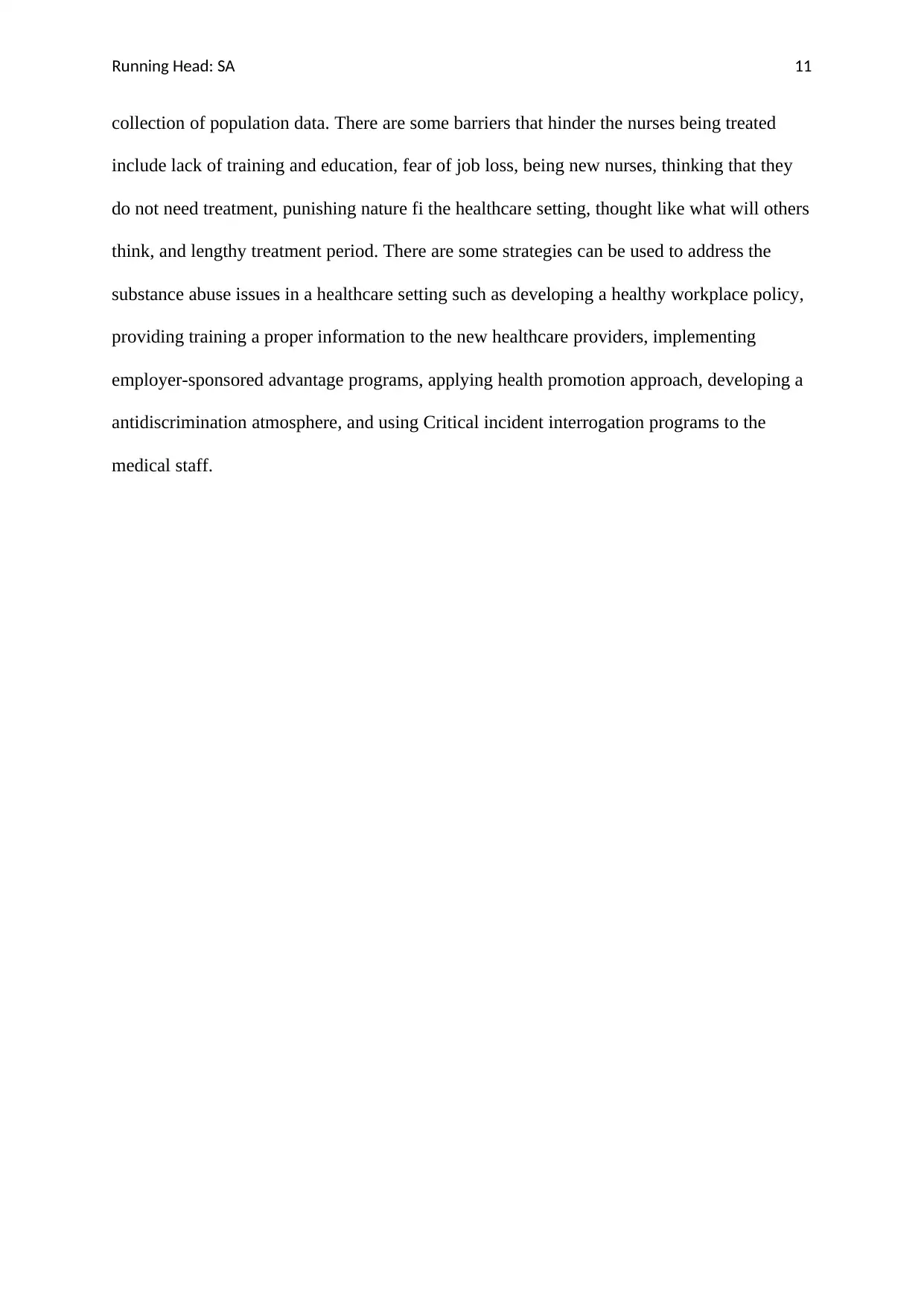
Running Head: SA 11
collection of population data. There are some barriers that hinder the nurses being treated
include lack of training and education, fear of job loss, being new nurses, thinking that they
do not need treatment, punishing nature fi the healthcare setting, thought like what will others
think, and lengthy treatment period. There are some strategies can be used to address the
substance abuse issues in a healthcare setting such as developing a healthy workplace policy,
providing training a proper information to the new healthcare providers, implementing
employer-sponsored advantage programs, applying health promotion approach, developing a
antidiscrimination atmosphere, and using Critical incident interrogation programs to the
medical staff.
collection of population data. There are some barriers that hinder the nurses being treated
include lack of training and education, fear of job loss, being new nurses, thinking that they
do not need treatment, punishing nature fi the healthcare setting, thought like what will others
think, and lengthy treatment period. There are some strategies can be used to address the
substance abuse issues in a healthcare setting such as developing a healthy workplace policy,
providing training a proper information to the new healthcare providers, implementing
employer-sponsored advantage programs, applying health promotion approach, developing a
antidiscrimination atmosphere, and using Critical incident interrogation programs to the
medical staff.
⊘ This is a preview!⊘
Do you want full access?
Subscribe today to unlock all pages.

Trusted by 1+ million students worldwide
1 out of 16
Related Documents
Your All-in-One AI-Powered Toolkit for Academic Success.
+13062052269
info@desklib.com
Available 24*7 on WhatsApp / Email
![[object Object]](/_next/static/media/star-bottom.7253800d.svg)
Unlock your academic potential
Copyright © 2020–2025 A2Z Services. All Rights Reserved. Developed and managed by ZUCOL.





